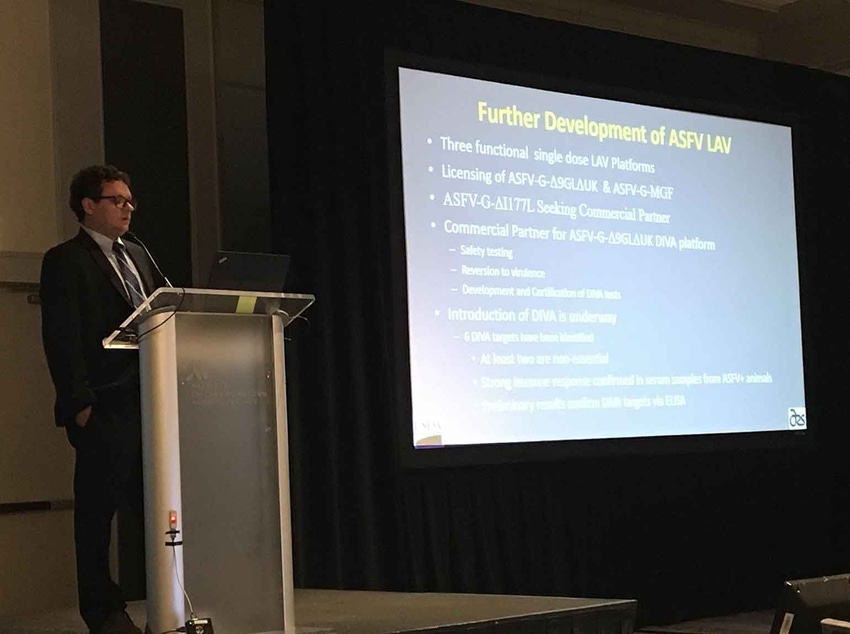Plum Island senior scientist details the process to finding an effective vaccine against African swine fever.

The large double-stranded DNA virus is the only member of the Asfarviridae family. It contains 150-plus genes and very few of these genes have been studied in detail. The initial cellular target for the virus is swine macrophages, and currently there is no stable cell line for virus or vaccine growth. Cell culture adapted virus strains tend to have large genomic selections deleted. The virus has more than 20 genotypes, and little is known about cross-protection between the different genotypes. These are just a few of the characteristics of the African swine fever virus, a virus that some scientists are now saying could wipe out a quarter of the world's pigs, and a virus in which there is currently no commercially available vaccine.
"We don’t know the protective immune mechanisms. The protective immunity from viral proteins are unknown. This makes it very hard to make a subunit vaccine," says Douglas Gladue. "Some people have tried and there are some experiments that have been done for subunit vaccines. However, any attempts have failed or gave only a very modest protection rate that has been no more than 20 to 50% of vaccinated animals conferring immunity to ASFV. Depending on the viral isolate the results of these subunit vaccines have also been contradictory. So far all of these experimental, subunit vaccines have only shown any positive results at very high doses which makes them commercially unviable."
The senior scientist at the USDA's Agricultural Research Service Foreign Animal Disease Research Unit at Plum Island Animal Disease Center says historically the USDA has looked at live attenuated vaccines, relying on the development of recombinant ASFV with gene deletions. This process is time-consuming and Gladue has been leading researchers to try to find faster alternatives for creating recombinant ASFV in field strains. The addition of fluorescent markers has allowed for faster purification of recombinant viruses and utilizing CRISPR-Cas9 gene editing technology has produced a 4-log increase in initial recombination, but Gladue says the development of live attenuated vaccines was largely based on research in the 1990s using historical isolates where deletion of non-essential virus genes involved in virus virulence in swine were used to make recombinant ASFV in the current outbreak strain.
"These historical deletions were successful in attenuating African swine fever Georgia, but not to the same extent of historical isolates. The need for safe, more attenuated vaccine led us to identify several new African swine fever protein targets," Gladue says.
To do this, the Plum Island team has created a custom computational pipeline that takes into account different sources of bioinformatics and functional genomic data and identifies several genetic targets for deletion. The researchers looked at the gene EP152R: a CCL2-like protein, which was essential and could not be deleted and they also examined L83L: an Il-1 binding protein but deletion of L83L did not attenuate the virus. They decided to focus their efforts on a previously uncharacterized gene, I177L that was identified by their pipeline.
Located on the reverse strand, I177L is highly conserved among all isolates. A late transcribed gene, I177L is predicted to be an immune modulatory protein. I177l was determined not to be an essential gene. Deletion of I177l only modestly affected virus growth in macrophages but high titer stocks needed for vaccine production can be achieved.
"With our new vaccine platform, we saw that we had the highest degree of attenuation for any live attenuated vaccine that protects against the African swine fever virus strain Georgia," Gladue says. "We had complete protection even at a dose of 102 and the vaccine lacks any residual virulence, even at doses as high as 106. This is the first ASFV vaccine that does not induce viral shedding and induces sterile immunity. ASFV-G-ΔI177L has the highest safety profile of any live attenuated vaccine that protects against African swine fever Georgia."
So, what are the next steps for the Plum Island team in developing an ASF live attenuated vaccine?
"We have three functional single-dose, live attenuated vaccine platforms. We have licensed our ASFV-G-Δ9GLΔUK and ASFV-G-MGF platforms. For ASFV-G-ΔI177L, we are seeking a commercial partner," Gladue says. "We have a commercial partner to develop a DIVA (Differentiating Infected from Vaccinated) platform in our double deletion platform, which will include safety tests and reversion to virulence, development and certification of the DIVA test. Right now, the introduction of DIVA and all of our platforms is under way. We have six DIVA targets that have been identified. We know at least two are non-essential and we've confirmed a strong immune response of serum samples from ASF-positive animals. Our preliminary results confirm that these DIVA targets work by ELISA, however, we know that a commercial DIVA compatible vaccine is probably still years away."
About the Author(s)
You May Also Like



.png?width=300&auto=webp&quality=80&disable=upscale)

